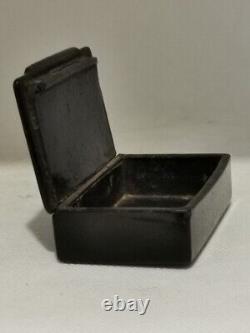
- Home
- Authenticity
- Matière
- Origine
- Sous-type
- Style
- 1940-1960 (159)
- Antique (72)
- Antiquity (164)
- Antiquité (301)
- Art Populaire (19)
- Directoire (32)
- Louis Philippe (69)
- Louis Xiii (39)
- Louis Xiv, Baroque (124)
- Louis Xvi (90)
- Moyen-âge (61)
- Napoleon Iii (207)
- Napoleon, Empire (29)
- Napoléon Iii (423)
- Napoléon, Empire (75)
- Ottoman (51)
- Renaissance (104)
- Restauration (32)
- 1900 (27)
- 1970 (31)
- Other (2936)
- Type
Blackened wooden snuffbox, checkered lid (Masonic) 17th 16th




Pocket snuffbox, made of blackened noble wood (probably Freemason). Lid decorated with a checkered pattern. A pocket snuffbox must be flat and small in size in order to easily fit in a pocket.
Its shape should help the hand hold it horizontally; its opening should be sufficient to allow pinching with two fingers and its closure perfectly airtight to avoid any unwanted moisture. Snuff tobacco, somewhat exotic, was mainly reserved for the delicate nostrils of aristocrats, and later for the bourgeois while chewing tobacco. Could only suit the coarsest mouths. Snuffing was initially done for medicinal purposes and later for pleasure. Men snuffing with their snuffbox in hand. Snuffing tobacco became very popular in Europe.In European salons, it was common to be interrupted in conversation by the sound of a sneeze, considered distinguished at the time. Women snuffed as eagerly as men. It was fashionable to change snuffboxes every day.
They readily matched the owner's clothes and moods. Extracted from a pocket or a small bag, they were passed from hand to hand in salons, allowing the determination of the social rank and wealth of the owner. As a result, the often decorated snuffboxes became the latest fashion accessory but also an important symbol of social status. As such, snuffboxes were often given as gifts or worn as jewelry. They were willingly offered as tokens of love with the portrait of a loved one, or to signify friendship.
Precious models, filled with silver or precious stones, became diplomatic or military gifts. King Louis XIV, who was not a snuff taker, had many of the most expensive snuffboxes made to give to representatives of foreign powers he had to deal with. Snuffboxes were mainly made of gold adorned with precious stones, from the Orient or in Martin varnish. With the passage of time and the rise of its culture, powdered tobacco from the farmers general, mainly manufactured in Morlaix, became highly appreciated.
Tobacco became increasingly popular and eventually reached all levels of society. Thus, during the Revolution, the snuffbox was no longer reserved for the wealthy, as tobacco became democratized and the common people snuffed. The snuffbox also became a rallying symbol for the sans-culottes and was widely used by the army. It was eventually replaced by the "pomponne", developed by two silversmiths, Turgot and Daumy, established at the end of the century in the Hôtel de Pomponne, rue de la Verrerie in Paris.
It was an alloy based on copper, intended to imitate gold or silver. They were granted a manufacturing privilege, whereas previously, all imitations were prohibited. Even the poorest peasants had their own "snuff box". Thus, initially sold only by apothecaries, tobacco eventually found its place behind grocery counters before joining certain gambling houses and drinking establishments called "tobacco shops". There are many shapes and sizes of snuffboxes, either pocket or table, depending on whether they are used outdoors or indoors.

